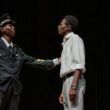Eleanor Marx, the youngest daughter of Karl Marx, was born in 1855. Her formal schooling was limited; school costs drained family finances and, in any case, she disliked school. But she was hardly averse to learning. The Marx residence was cramped and raggedly furnished. Shortages of food, clothing and medicine were facts of life. Rent and bills were overdue. Yet, pen, paper and books were in abundance, a veritable haven for an avid reader. Apart from acting and gymnastic lessons, she was a product of home schooling and self-education. Parents, sisters, and family friends—major socialist and cultural luminaries of the day—were her tutors.
Her principal teachers were Karl Marx and god-father Friedrich Engels. As Marx drafted The Capital at a cluttered desk, she played and pestered him with questions. He would put her on his lap to recite a long tale that brought his theory of political economy alive in a fictional form. Her keen insight into Marxian economics originated from those fatherly lessons. Gently guiding her via letters, books, one-to-one talks and visits to working class areas, Engels acquainted her with intellectual gems of varied hues.
In her multilingual abode, she learned German, French and English from an early age. Her fun-filled literary diet combined popular children’s books with Homer, Shakespeare, Don Quixote, Shelly, The Arabian Nights and more, mostly recited her father. By age five, she had large chunks of these tomes in memory. Her readings spanned a diverse terrain. To grasp Ibsen, she learned Norwegian on her own. Chess was a joyful diversion. Imbibing tactical moves from nanny Helen Desmuth, she deployed them to trounce her venerated father. From Engels, she learned Chess history, widening her cultural horizon. She went to sea resorts, museums, parks, bookshops and, when her parents could afford it, theatrical and musical performances. When they later moved to a roomier abode, she delighted in caring for kittens, puppies and birds. Hers was a one-of-a-kind education in a home brimming with love and erudition.
She developed independent views on Irish, Polish, English and Italian politics and working class struggles from early teen years. By age 16, she was effectively Marx’s secretary. Accompanying him to meetings, she interacted with leading voices of the day. Her intellectual rapport with her father was such that he anointed Engels and herself as the two executors of his literary estate. It was a responsibility she executed with diligence.
To boost the meagre family income, Eleanor worked as a private tutor and school teacher, wrote articles for magazines and did paid odd jobs for writers and publishers. Yet, above all, she was an activist. When the Paris Commune was on the defensive, she and her elder sister landed in Paris under assumed names at a great risk to themselves. They carried letters between the communards and their supporters, and were briefly locked up. Subsequently, Eleanor worked with a leading communard to write, translate and revise the History of the Commune of 1971, a primary source for books and papers on the Paris Commune that were written later.
Eleanor’s views on women were rooted in the loving care she had from her mother, nanny, and aunt Annie Burns. Their dignified resilience, elemental sagacity and love for family and humanity infused her with profound empathy for women everywhere.
The Paris Commune reinforced those feelings. Among the lessons she imbibed from the short-lived state was the centrality of women in the fight for a just society. The fight for gender equality had to proceed in tandem with the fight for basic economic transformation. It was a time when women in Europe were confined to domestic servitude and worst paid risky jobs. They could not vote, hold office, enter universities or join a profession. Socialists often posited attainment of socialism as a prerequisite for gender equality. Middle class feminists focused on the right to vote, education and equal pay for equal work, but not on basic social change. Disagreeing with both, Eleanor proclaimed that the miserable lives of working class women could be transformed only by integrating class struggle with the struggle for gender equality—in the home, education, public affairs and work. She earnestly implemented that strategy by assisting female candidates for municipal office, combatting sexism in the trade unions and political groups, advocating sex education and repeal of anti-women legislation, and frequent lectures on socialism to female workers. One of her campaigns covered Jewish women working in hazardous, abysmally paid jobs and also victimized by anti-Semitism and misogyny. To better interact with them and support their strike, she enhanced her linguistic repertoire by learning Yiddish.
Eleanor enriched feminism in practice and theory. Her vision emanated from Marx and Engels, in particular, the incisive analysis of Engels in the Origin of Private Property, Family and the State, and from general contacts with women. Her articulation of progressive feminism was clearer and more poignant than of Marx or Engels. Proposing concrete program for socialist feminism, she joined struggles waged by working class women. The book she co-authored with her partner Edward Aveling—The Woman Question—remains one of the most erudite works on the liberation of women.
Women are the creatures of an organized tyranny of men, as the workers are the creatures of an organized tyranny of idlers. … [Those] who attack the present treatment of women without seeking for the cause of this in the economics of our latter-day society are like doctors who treat a local affection without inquiring into the general bodily health. (Aveling and Marx 1886).
While women should unite across class lines, working class women should not forget the role of upper class women in their subjugation. Working men subjugate working women, and do little to alleviate the 24-hour domestic drudgery women endure. Patriarchic tendencies within trade unions and work places must be eliminated. Yet, solidarity across class lines should not come at the expense of solidarity between working women and men. Eleanor’s feminism enriched and was enriched by radical feminists like Annie Besant, Rosa Luxemburg, Olive Schreiner and Clara Zetkin. In 1909, Clara Zetkin and other radical women took the call of the Socialist Party of America a step further to launch the International Women’s Day. Now marked each year, Eleanor’s vision lives on.
Her involvement in trade union and worker’s struggles was nothing short of legendary. Starting with the Women’s Trade Union League in 1986, she focused on publicizing work conditions in factories employing young girls, organized industrial action and galvanized support for the strikers. As one of the leaders of the Bloody Sunday demonstration in London in 1987 and other rallies, Eleanor not only organized behind the scene, but also gave speeches and faced police batons. When men activists took to their heels, she stood her ground, imploring others to do likewise and was roughed up. Her publicized reports firmly castigated police violence against activists and women.
Eleanor was a major force in the establishment of political parties with a socialist program. After joining the Social Democratic Federation and being elected to its executive board, she became disenchanted with the reformist, chauvinistic agenda adopted by its main leaders. Together with William Morris and others, she founded the Socialist League. Though sidelined by conservative, envious male union leaders, she attended the inaugural conference of the Independent Labor Party as an influential observer. But her efforts to direct the Party’s program towards socialism based on class struggle did not take off. So she returned to a reinvigorated Socialist League. Even as her views did not carry the day, her spirited, lucid oratory always moved the delegates.
Eleanor was a valued editor and a prolific translator. She edited four key works of Karl Marx, and translated important works by leading socialists into English. Her presence on the cultural arena included translating four plays of Henrik Ibsen and the controversial Madame Bovary. She acted in plays, wrote incisive essays on Shelly that depicted him as a socialist poet and engaged in extended dialogs with literary dignitaries like George Bernard Shaw, Olive Shriner and William Morris. To her, the stage was an important medium for the feminist cause. After extensive research, she began to draft a biography of her father. Though it remained incomplete, it provides material unavailable from other sources.
As a public orator, she had few equals. Her vibrant speech at the first May Day rally in London in 1890 highlighted the event. Her lectures in 35 US cities drew appreciative crowds. In plain terms, she negated the media distortions about socialism. For working people, they were an eye opener. Lambasting the hazardous conditions in factories and mines, she joined the ongoing campaign for an 8-hour work day and against child labor. Where a strike was on, she joined in. Even the largely hostile media acknowledged her erudition, charisma and modest demeanor.
Like Marx and Engels, Eleanor was an internationalist who decried the jingoistic attitudes of union and political leaders. Her sympathies extended to the people in South Africa, India and Sudan. When British imperial forces under General Gordon were defeated by the Sudanese resistance, she declared it a victory for working people and blasted the cries for revenge.
She was never baptized, made to pray or attend church service. But her father educated her about Jesus Christ and early Christianity. She realized that at outset, Christianity had stood for the underdog. Later it was usurped by kings and popes. To those who ascribed the oppression of women to purely religious, cultural factors, she said, that women’s `social condition is a question of economics, not of religion or of sentiment.’ Though a life-long socialist atheist, she respected the right of people to practice their faith and appreciated the basis of popular religiosity. In particular, she loved taking part in Christmas celebrations with children.
Eleanor was a compassionate, respectful, dignified being. Her courtesy extended to allies and foes alike. Her mild-mannered persona, modest attire and plain hair style did in no way detract from a magnetic presence and proclivity for incisive talk. Her voluminous correspondence with family, comrades, Engels and others attests to a sparkling intellect.
Utterly devoted to her family, she spent three years taking care of ailing parents. Her partner’s reluctance prevented her from bearing a child. But she loved children and was delighted when her nephews paid a visit. Like her father had done for her, she spoilt them while educating them at the same time.
Tragically, the life of this majestic human being was smudged by a dark stain. In 1884, she became the common law wife of Edward Aveling, a well-known secularist and socialist. It took her a while to realize that he was a serial womanizer who loved luxurious living. Aveling misused her earnings, did not repay the loans he took from their friends and embezzled union and party funds. Yet she remained loyal to him and took care of him whenever he fell ill. In 1898, just after she had nursed him back to his feet, she learned that he had married a younger woman. It was the last straw. She ended her anguish by taking poison. She was just 41. A noble woman who had valiantly campaigned against misogyny was felled down by a vulgar misogynist.
Eleanor Marx’s life, ideas and struggles remain pertinent in this neo-liberal age. Her central message—the struggle for gender equality has to go hand in hand with the overall struggle for social justice and equality—is critical for countering the current NGO dominated fragmentation of the struggles for civil, human, social, economic and gender rights.




